1950s
Cinderella’s Bad Influence
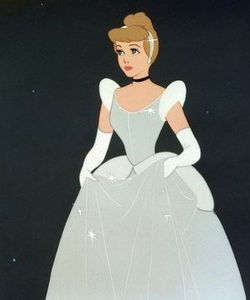
In the 1950s, Dr. John Kershaw, an English medical officer, argued that, "The expectation of meeting a dream lover and automatically living 'happily ever after' keeps children from being taught 'to realize the difficulties and responsibilities of marriage.'"
More recently, Cinderella has been attacked for the "princess culture" that it cultivates. From the Sentinel & Enterprise (3/22/2012):
"Cinderella is remarkably passive throughout the entire movie," Moser said, adding that Prince Charming didn't take much of his life into his own hands either and relied greatly on his father.
Rather than make her own dreams come true, he said, Cinderella waits for others, such as her fairy godmother, to do the work for her, and trusts that things will turn out right.
The message it sends is that it is best to buy into the status quo and that one's dreams can be achieved by following the rules set by previous generations, Moser said.
NY Times critic Peggy Orenstein has even written a bestselling book on this subject, Cinderella Ate My Daughter (2011).
To the best of my knowledge, I've never seen Cinderella. Perhaps I should consider myself lucky for having escaped its poisonous influence.
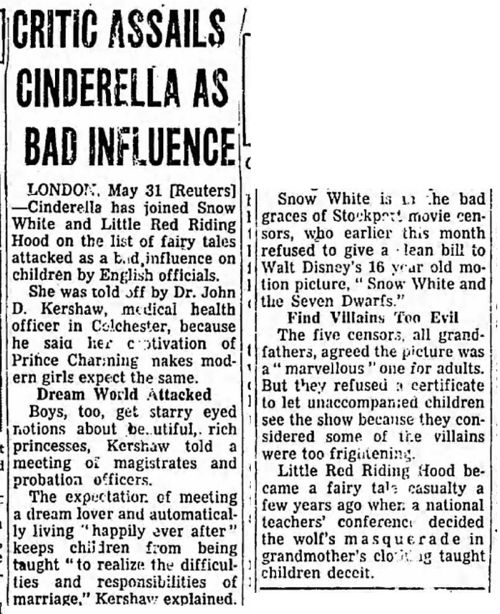
Chicago Daily Tribune - June 1, 1954
Posted By: Alex - Wed Jan 04, 2017 -
Comments (4)
Category: Movies, Myths and Fairytales, 1950s
Mystery Illustration 36
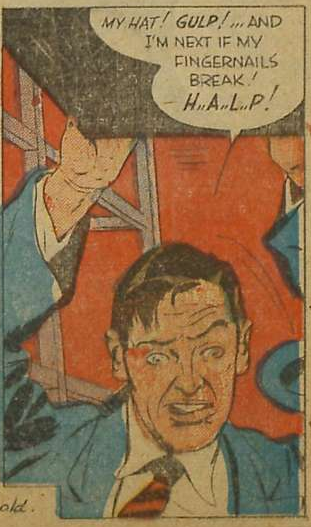
You guys did pretty good guessing Danny Kaye some time ago. So who is this world-famous comedian?
The answer is here.
And after the jump.
More in extended >>
Posted By: Paul - Wed Jan 04, 2017 -
Comments (2)
Category: 1950s, Comedians
The Tattooed Lady
Not the Groucho song.
Posted By: Paul - Mon Jan 02, 2017 -
Comments (2)
Category: Music, 1950s, Tattoos
Cuckoo Girl
Justin Bieber fangirl phenomenon, 1959 version.
Posted By: Paul - Wed Dec 28, 2016 -
Comments (3)
Category: Bad Habits, Neuroses and Psychoses, Celebrities, Delusions, Fantasies and Other Tricks of the Imagination, Music, Teenagers, 1950s
Atomic Dog Tags
September 1950: The AMVETS organization announced its plan to issue plastic dog tags to all civilians in the United States, to help identify people in case of an atomic emergency. The tags would carry the wearer's name, address, and blood-type. The tags were plastic in order to "prevent radiation effects in the event of an atomic explosion."AMVETS hoped to have the tags issued to all Americans within 18 months, but obviously that never happened.
Some searching has revealed that President Truman and actress Doris Day were presented with their own atomic dog tags, but I'm not sure that anyone else ever got one.

Philadelphia Inquirer - Sep 29, 1950
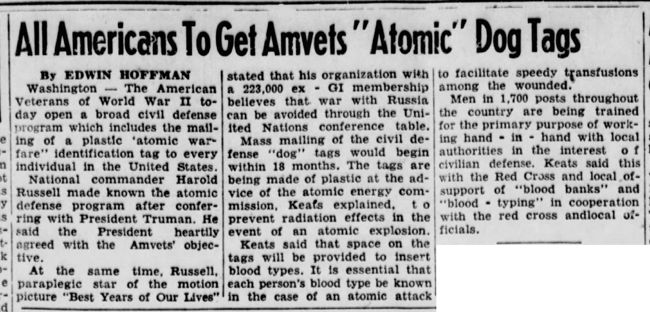
New Philadelphia Daily Times - Sep 28, 1950
Posted By: Alex - Mon Dec 19, 2016 -
Comments (3)
Category: Atomic Power and Other Nuclear Matters, 1950s
Betty Reilly, The Irish Senorita: “The Saga of Elvis Presley”
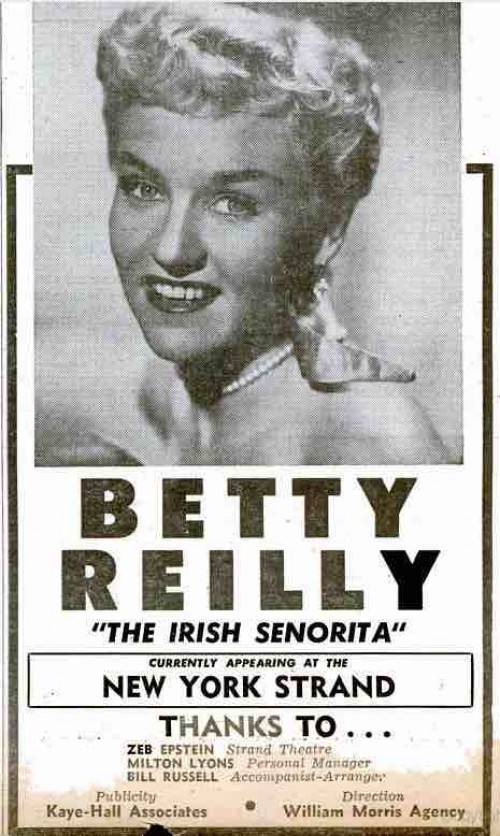
Poor forgotten Betty Reilly does not even get a Wikipedia entry, but she had a shtick--and some talent.
The song that she is parodying is in the last video.
Posted By: Paul - Sun Dec 18, 2016 -
Comments (0)
Category: Music, Stereotypes and Cliches, 1950s, Parody
Human Air Raid Siren
January 1951: The Colorado Civil Defense Department received a letter from a woman volunteering to become the state's "first air raid siren."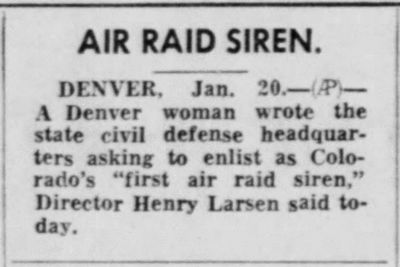
Terre Haute Tribune - Jan 21, 1951
Perhaps they should have used her. When non-human sirens were installed the following year they reportedly didn't elicit much reaction. From Colorado: A History of the Centennial State:
Posted By: Alex - Fri Dec 16, 2016 -
Comments (6)
Category: 1950s
Miss Mona Lisa 1958
February 1958: A jury of "celebrated painters" convened for the Mona Lisa Grand Prix awarded the title of "Mona Lisa 1958" to Luce Bona. What made the award slightly unusual is that Bona hadn't been a contestant. The judges just happened to see her as she was walking by outside and decided she was the one. At least, that was the story reported in the press.

Louisville Courier-Journal - Feb 19, 1958
Here's the winner from the previous year, Maria Lea. Apparently the gimmick of this contest was that the winner posed in a picture frame, which made her somehow like the Mona Lisa.

The Lincoln Star - Jan 13, 1957
Later in 1958 a jury of French mystery writers selected Luce Bona as the girl with the "Most Devilish Eyes." I'm assuming she was actually entered into that contest.
I can't find any references to Luce Bona after 1958. Perhaps she gave up modeling, despite such a promising start.
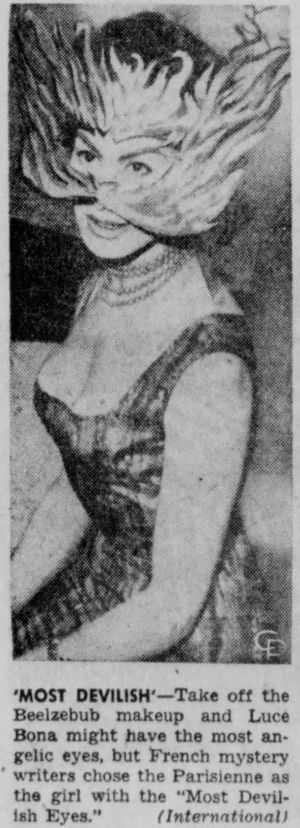
Wilmington News Journal - Apr 12, 1958

Posted By: Alex - Mon Dec 05, 2016 -
Comments (8)
Category: Art, Awards, Prizes, Competitions and Contests, Beauty, Ugliness and Other Aesthetic Issues, 1950s
The Tubby Hubby Diet
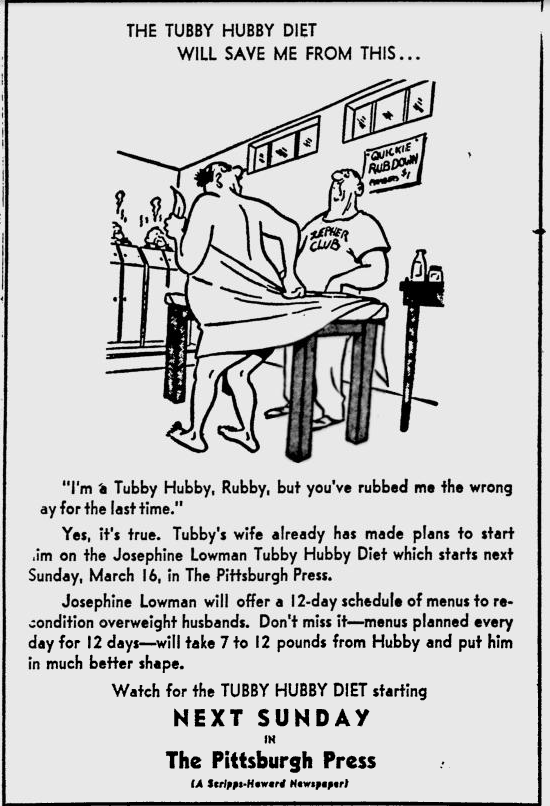
Original ad here.
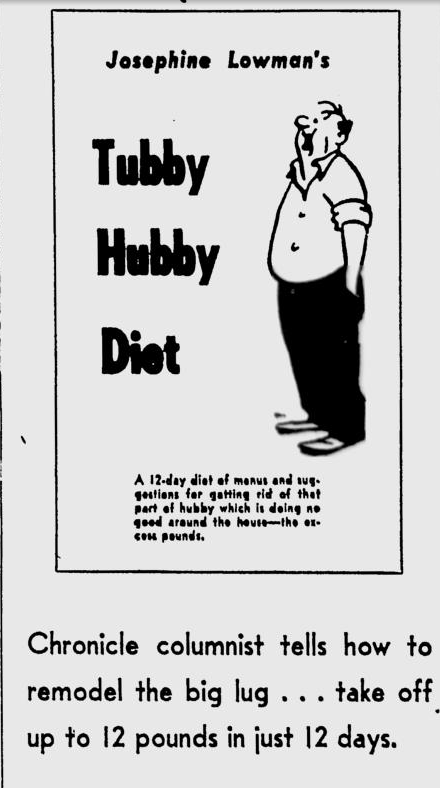
Original ad here.
I just cannot believe the arrogant sexism and objectifying behavior of Josephine Lowman! I feel cheap and soiled, on behalf of all tubby hubbies.
LATE ADDITION TO THE POST: I could not resist adding this new term I just thought of: "schlub-shaming."
Posted By: Paul - Thu Dec 01, 2016 -
Comments (1)
Category: Body, Dieting and Weight Loss, Public Humiliation, 1950s
Hypnotist Seeks Humane Turkey Death
November 1956: Hypnotist Arthur Ellen urged President Eisenhower to put his Thanksgiving turkey in a trance before executing it, promising him that a hypnotized turkey "tastes better due to the absence of adrenalin in the bloodstream and plucks easier because the muscles holding the feathers are relaxed."
Port Angeles Evening News - Nov 19, 1956
It's not recorded whether Eisenhower took the advice of the hypnotist. However, Wikipedia notes that, "The Eisenhower Presidential Library says documents in their collection reveal that President Dwight Eisenhower ate the birds presented to him during his two terms."
The tradition of Presidential turkey pardons only officially began with Reagan, although both Kennedy and Nixon spared some birds.
Below: Eisenhower in 1954 feeds a cranberry to a soon-to-be-eaten Thanksgiving turkey.

Image source: White House Historical Association
Posted By: Alex - Thu Nov 24, 2016 -
Comments (0)
Category: Holidays, Thanksgiving, Hypnotism, Mesmerism and Mind Control, 1950s

| Who We Are |
|---|
| Alex Boese Alex is the creator and curator of the Museum of Hoaxes. He's also the author of various weird, non-fiction, science-themed books such as Elephants on Acid and Psychedelic Apes. Paul Di Filippo Paul has been paid to put weird ideas into fictional form for over thirty years, in his career as a noted science fiction writer. He has recently begun blogging on many curious topics with three fellow writers at The Inferior 4+1. Contact Us |




